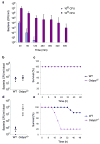Function of C/EBPdelta in a regulatory circuit that discriminates between transient and persistent TLR4-induced signals
- PMID: 19270711
- PMCID: PMC2780024
- DOI: 10.1038/ni.1721
Function of C/EBPdelta in a regulatory circuit that discriminates between transient and persistent TLR4-induced signals
Abstract
The innate immune system is like a double-edged sword: it is absolutely required for host defense against infection, but when uncontrolled, it can trigger a plethora of inflammatory diseases. Here we use systems-biology approaches to predict and confirm the existence of a gene-regulatory network involving dynamic interaction among the transcription factors NF-kappaB, C/EBPdelta and ATF3 that controls inflammatory responses. We mathematically modeled transcriptional regulation of the genes encoding interleukin 6 and C/EBPdelta and experimentally confirmed the prediction that the combination of an initiator (NF-kappaB), an amplifier (C/EBPdelta) and an attenuator (ATF3) forms a regulatory circuit that discriminates between transient and persistent Toll-like receptor 4-induced signals. Our results suggest a mechanism that enables the innate immune system to detect the duration of infection and to respond appropriately.
Figures





References
-
- Janeway CA, Jr, Medzhitov R. Innate immune recognition. Annu Rev of Immunol. 2002;20:197–216. - PubMed
-
- Aderem A, Ulevitch RJ. Toll-like receptors in the induction of the innate immune response. Nature. 2000;406:782–787. - PubMed
-
- Medzhitov R. Toll-like receptors and innate immunity. Nat Rev Immunol. 2001;1:135–145. - PubMed
-
- Nathan C. Points of control in inflammation. Nature. 2002;420:846–852. - PubMed
-
- Kobayashi KS, Flavell RA. Shielding the double-edged sword: negative regulation of the innate immune system. J Leukoc Biol. 2004;75:428–433. - PubMed
Publication types
MeSH terms
Substances
Grants and funding
LinkOut - more resources
Full Text Sources
Other Literature Sources
Molecular Biology Databases
Miscellaneous

